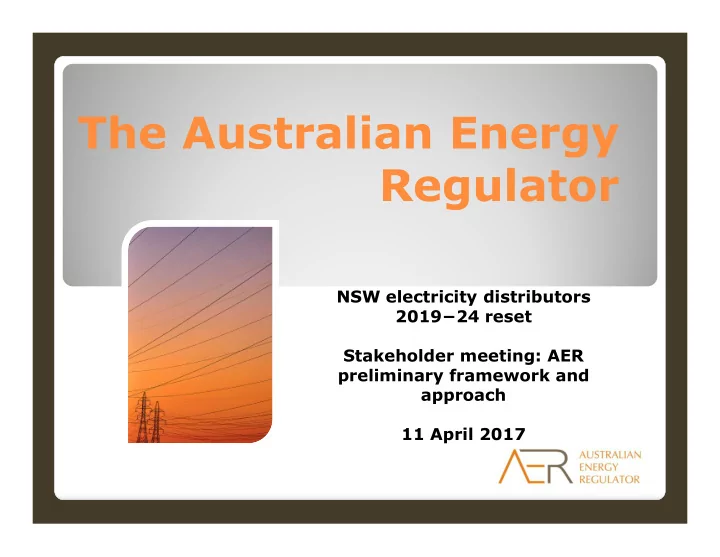

The Australian Energy Regulator NSW electricity distributors 2019−24 reset Stakeholder meeting: AER preliminary framework and approach 11 April 2017
Agenda � The AER and the Consumer Challenge Panel (CCP) � Regulatory framework incl. Framework and approach (F&A) � NSW preliminary F&A � Reset timeline � Service classification guideline 2
The AER’s role in NSW energy Distribution Wholesale gas & Transmission Retail electricity Networks for networks & & other markets gas/electricity pipelines distribution We regulate revenues We regulate revenues We monitor wholesale We will regulate non- of transmission of distribution markets and enforce rules price retail activities businesses businesses Prices in the NEM are set by National Energy Customer Distribution prices and Charges set by AER the market subject to the Framework - AER structures – AER approves NER Transmission loss annually subject to Retail price approach – factors method set by determination and NER AER monitors market NSW Govt. AEMO outcomes and behaviour Reliability standards – set by NSW Govt. Regulatory investments Incentive schemes – tests – AER assesses defined in NER and set by compliance AER at reset Rate of return – NER and AER guideline – set at reset for 5 years
Regulatory framework (1) � Decisions must contribute to achievement of the NEO – efficient investment in, & efficient operation & use of, electricity services for the long term interests of consumers. 4
Regulatory framework (2) � Key aspects of NER: ◦ Regulatory asset base – not re-valued ◦ Rate of return – benchmark efficient firm ◦ Capex and opex objectives – efficient, meet demand, obligations ◦ Depreciation ◦ Tax allowance ◦ Incentive schemes 5
Regulatory framework (3) � The building blocks (how prices are derived): Return on capital (forecast RAB × cost of capital) Capital costs Regulatory depreciation (depreciation [net of indexation] applied RAB) Operating expenditure (opex) Total revenue Efficiency benefit sharing scheme (EBSS) (increment or decrement) Corporate income tax (net of value of imputation credits) 6
Framework and approach � 1 st step in 2 year reset process � F&A determines: ◦ Service classification (limited discretion and sets ring-fencing obligations) ◦ Form of control mechanism (binding) ◦ Control mechanism (limited discretion) ◦ Application of incentive schemes (flexible) ◦ Approach to depreciation (flexible) ◦ Application of expenditure forecasting guideline (flexible) ◦ Dual function assets (binding) 7
NSW preliminary F&A Service classification – what service we will regulate � 8
Service classification � Only proposed changes from 2014-19 are: ◦ Metering coordinator, metering provider and metering data provider roles – unregulated distribution services from 1 December 2017. ◦ Unregulated distribution services – for businesses to review their revenue streams to propose list of services. Impacts on ring- fencing obligations. ◦ Emergency recoverable works from unregulated to standard control. 9
Form of control � No change to current approach: ◦ Standard control services – revenue cap ◦ Alternative control services – price cap. 10
Incentive schemes � Intend to apply: ◦ Service target performance incentive scheme (STPIS) ◦ Efficiency benefit sharing scheme (EBSS) ◦ Capital expenditure share scheme (CESS) ◦ Demand management incentive scheme (DMIS) � DMIS & STPIS review – complete late 2017 � New schemes expected to be applied to NSW businesses 11
Depreciation, benchmarking, DFA � Intend to apply: ◦ Forecast depreciation (combined with CESS provides incentive to pursue capex savings). ◦ Forecast expenditure guideline - apply the assessment/analytical tools set out in the guideline and any other appropriate tools for assessing expenditure forecasts ◦ Ausgrid’s dual function assets (DFA) – apply transmission pricing ◦ Endeavour Energy’s DFAs – apply distribution pricing ◦ Essential Energy does not have any DFAs. 12
NSW reset timeline Step Date Submissions close – preliminary F&A 21 April 2017 AER to publish final F&A for NSW distributors July 2017 NSW distributors submit regulatory proposals to January 2018 AER AER publishes Issues paper and holds public Feb/March 2018 forum Submissions on regulatory proposal close May 2018 AER to publish draft decisions September 2018 NSW distributors to submit revised regulatory December 2018 proposals to AER Submissions on revised regulatory proposals and January 2019 draft decision close AER to publish final distribution determinations April 2019 for 2019-24 13
Service classification guideline � Guideline development will commence once Service AEMC classification Ring-fencing contestability rule change complete (late 2017) Cost allocation � Guideline method completed in early 2018 – will likely Shared apply to NSW assets businesses 14
Questions � Questions? � Contact the AER at: ◦ ausgrid2019@aer.gov.au ◦ endeavourenergy2019@aer.gov.au or ◦ essentialenergy2019@aer.gov.au 15
Recommend
More recommend